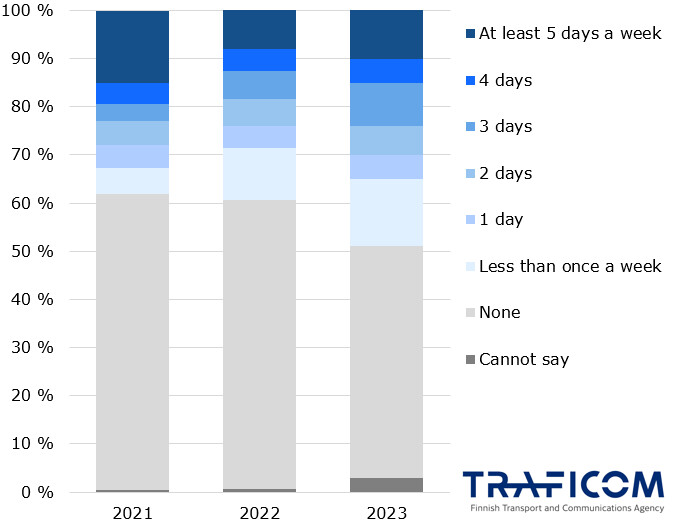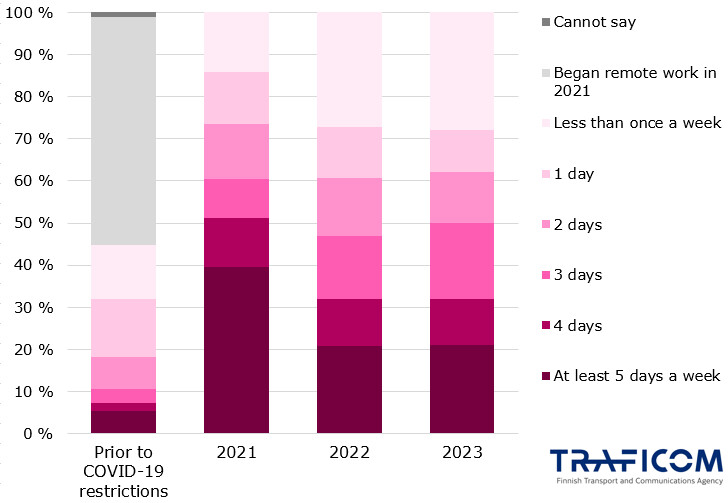Finnish Transport and Communications Agency Traficom’s consumer survey indicates that remote work is more prevalent than before the COVID-19 pandemic among working-age people who have the option of telecommuting. However, the majority of working-age people work remotely less than once a week, with half telecommuting no more than two days a week.
Approximately half of Finnish working-age people between the ages of 25 and 65 worked remotely at least occasionally at the end of 2023, as revealed by Traficom’s annual consumer survey on the use of communications services and devices. “For most telecommuters, having a broadband connection is essential for being able to work, with the lack of a reliable connection preventing or at least hindering remote work. One of Traficom’s tasks is to promote the availability of broadband connections to everyone,” states Senior Specialist Marja Heinonen. The number of people who have worked remotely has increased since last year’s survey. When it comes to examining the magnitude of the change, it should be noted that in previous years the survey was conducted differently, which increases the margin of error somewhat.
Based on the results of the survey, especially the number of people who only occasionally telecommute keeps increasing year-by-year. In 2021, the share of working-age people who worked remotely less than once a week was 5%, whereas in 2023 the corresponding figure was 14%. The numbers of people working remotely weekly or several times a week have not significantly increased since the COVID-19 pandemic. The share of people working exclusively remotely has remained consistent at approximately 10% for the last few years.
Half of working-age people do not telecommute at all
One half of working-age people do not work remotely at all. The most common reason given for not telecommuting is work tasks that cannot be performed remotely (approximately 60%). In very rare cases (less than 10%), the reason is that the person does not want to work remotely or their supervisor would be opposed to it. Some consumers mentioned that their workplace is at home (such as self-employed persons), in which case work carried out at home is not remote work.

Number of telecommuting days has stabilised
While the number of telecommuting days has clearly decreased since the height of COVID-19 restrictions in 2021, it has still stabilised to a higher level than before the pandemic. In 2023, approximately a third of telecommuting working-age people worked remotely less than once a week, while half of working-age telecommuters worked remotely for the majority of the week.
Whereas in 2021 nearly 40% of consumers worked remotely all week, in the following year the percentage decreased to 20% and seems to have since stabilised to this level. “During and after the COVID-19 pandemic, many organisations and companies may have offered full-time remote work contracts, for example, which may have also led to workspaces being downsized. Based on the survey results, some work that was previously carried out at offices can continue to be performed exclusively remotely,” Heinonen notes.

Households no longer need internet connections for work or studies to the extent that they did at the height of the COVID-19 pandemic. For example, in 2020 the percentage of consumers who needed their home internet connection for studies on a weekly basis was 27%, whereas in 2023 the corresponding figure was 19%. The share of consumers who need their home internet connection to perform tasks related to a position of trust on a weekly basis has remained stable at approximately 15% throughout the survey years.
However, the percentage of consumers who need a home internet connection for work is higher than before the COVID-19 pandemic, which indicates that weekly telecommuting has become a permanent habit for some consumers. In 2019, the share of consumers who needed an internet connection for work or self-employment was 32%, whereas in 2023 the corresponding figure was 36%.
About the survey
The consumer survey was carried out by Verian (Mantle Finland Oy). Responses to the survey were received via an online form from 2,162 persons aged 18 or over. The survey was conducted in December 2023. The survey’s maximum margin of error is 2.2% in either direction.
It should be noted that the margin of error is larger than in the individual survey when comparing the survey results from different years. In previous years, the survey was carried out on a similar sample size through telephone interviews, which may have some effect on the results.
Further information
Results table of the communications services consumer survey 2023 (in Finnish) (External link)
Broadband penetration in households (External link)
Marja Heinonen, Senior Specialist, tel. +358 29 534 7355, marja.heinonen@traficom.fi